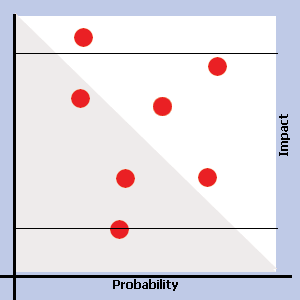Risk management is the process of measuring, or assessing, risk and developing strategies to manage it. Strategies
include transferring the risk to another party, avoiding the risk, reducing the negative effect of the risk...
more
Managing a multitude of internal and external risks is one of the most
significant challenges facing global organizations today.
Operational risks have been associated with business since the advent of
commerce.
More
Financial risk management is the practice of creating value in a firm by using
financial instruments to manage exposure to risk.
More
Risk Management Software
Definition: Risk Management is the identification and evaluation of
risks to an organisation - including risks to its existence, profits and
reputation - and the acceptance, elimination, controlling or mitigation of
the risks and the effects of the risks.
What does risk management software do?
Assessing risks and opportunities within a business can have a big effect on the successful
implementation of new strategies and completion of
projects and individual tasks. It's
often difficult to prioritise tasks to reduce risks to a minimum and increase opportunities.
Risk management software is designed to help with this process. It provides visual aids
to help sort low priority jobs from high priority ones and hence concentrate your efforts
on the tasks that will produce the best results most quickly. big effect on the successful
implementation of new strategies and completion of
projects and individual tasks. It's
often difficult to prioritise tasks to reduce risks to a minimum and increase opportunities.
Risk management software is designed to help with this process. It provides visual aids
to help sort low priority jobs from high priority ones and hence concentrate your efforts
on the tasks that will produce the best results most quickly.
There are two main factors determining the importance of a particular risk:
Probability – the chance that a particular adverse circumstance will come about.
Assessing the probability of a particular event is a good part of determining the overall risk.
Cost – the price you will have to pay if an adverse event occurs.
Balancing these two factors is the main way in which risk management software can
help you assess your best course of action. If you have a risk which is very probable,
but has only a low cost, it may not take as high a priority as a less likely occurrence
which has a very high cost.
Risk Management can be a costly business. If you try and take account of all possible
risks and allocate resources to remove them or mitigate against them, you’ll waste those
resources if the risky events don't happen. The ideal management of risk is one which
allocates as few resources as possible, while still reducing risks by the maximum amount.
There are four main ways of reducing risk:
Risk avoidance – don’t do something which might be risky. This is an obvious way to
reduce risk, but it also reduces the possibility of gains.
Risk reduction – put measures in place to act against the risk. For example, install a
burglar alarm to reduce the risk of robbery in a building.
Risk retention – accept the consequences of a particular risk. Normally only suitable for
low-level risks, it can be more cost-effective than insuring against them. For example,
accepting an excess charge on a typical car insurance.
Risk transfer – getting somebody else to take the risk. The most obvious example is taking out
insurance, but you may also be able to arrange risk transfer by writing it into a contract with,
for instance, a subcontractor.
Risk Management Software can help you make decisions on all four forms of risk management by
showing you which risks are the most important and how likely they are to occur. By using
techniques such as Monte Carlo analysis, you can also determine the likely cost of particular risk.
|
 big effect on the successful
implementation of new strategies and completion of
big effect on the successful
implementation of new strategies and completion of